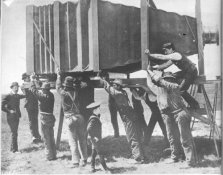Here is more, from the Encyclopedia of Photography, Vol. 11, p. 1990:
"The construction of the world's largest camera in 1900 resulted from an order for "a perfect contact picture not less than eight feet long" - the subject, a new Chicago & Alton railroad train. Lawrence (George R. Lawrence) explained that with existing cameras he could only make sectional views and piece these together. This, officials felt, would never do.
With assistance from J. A. Anderson, a local camera builder, Lawrence designed a special camera for the job. It weighed some 1400 pounds and required 15 men for its operation. The camera's bellows extended 20 feet on wheels running upon a steel track; the plate holder size was 10 x 6 feet, making possible pictures measuring
8 x 4 1/2 feet, or three times the largest print previously available.
Lenses used were the largest ever ground for photographic work, one being a wide angle affair of 5 1/2 feet equivalent focus, the other a telephoto rectilinear lens of 11 feet equivalent focus. The camera featured a rising and swinging back and front, a sheet of transparent celluloid for focusing, and light-proof curtains, resembling window shades, to protect the negative before and after exposure.
A "door" in the bellows permitted access to the interior where a man with a camel's-hair brush could dust off the plate before exposure. Plates were manufactured to special order at a cost of $1800 per dozen." (Note: these were 1900 dollars).
I wonder how they developed the plates..?




